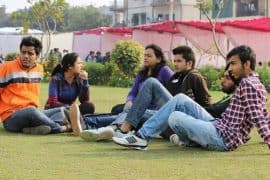On this Teacher’s Day, these alternative techniques of teaching give a newer perspective to the rugged old system. They highlight how education system can evolve with the ever-changing world, and keep up with the needs of the 21st century students.
It’s funny how my aunt and I share an age gap of 20 years, and yet she and I studied for our class 12th from the same book. The ideology followed in 1970s is the same that is being used today, even after witnessing an IT, economical and industrial revolution.
The students are often put to the same rat race, with lack of practical and relevant knowledge in pure, blind thirst of marks. This system shapes great cramming skills, but professional ones lack manifold.
Here are few alternative theories of teaching that need to be learnt by our education system:
- Flip the classroom:
One of the best alternative teaching methods is implementing a flipped classroom. Rather than lecturing in class, students watch or read lessons at home, and complete hands-on experiences while in class. This helps the student to have their own interpretation of the topic and not feel left out in the class. The “homework” becomes the lesson, and the “lesson” becomes the action! It also gives them enough time to prepare questions and analyse the chapter well.
- From the only one to one-to-one:
It’s amusing how countries like Australia have introduced robotics in their national development schemes but India, the country on the frontline of IT revolution is light years behind. One single teacher in a class of 40 students prevents holistic learning of each student, also adding pressure on the one teacher to reach all the students. Using personal technology as a tool will be a great boon. This could include the use of interactive websites, web quests, videos, and other activities, and could even be utilised as a tool for quick formative assessments and class dialogue. Many research have shown that because of class pressure, many students even hesitate to ask questions, this is a great alternative for that.
Nawang Dolma, first-year Philosophy student, Daulat Ram College said, “My history teacher only teaches in Hindi, which I don’t know well, being from Ladakh. It becomes a huge problem for me in class. I have to go back home and see video lectures in English.”
This method also helps to accommodate diversity in schools and colleges.
- Colour scheming, all the way:
A lot of students have a huge problem memorising information, especially in Arts courses. Teaching through the medium of different colours helps in clarity and visual comprehension of information. This also helps in making mind-maps, which get imbibed in the mind much faster and stronger. This alternate method takes you away from the rusty book to a more clarified text.
- How Genius is Genius Hour:
An hour dedicated to the practicality of the lesson. Throughout college and school, students always ask this question, “Where will I use this concept?” This hour will answer that question. Not only this, it will help students realise the scope of their text, but will also act as a navigation for their respective careers. A great tool for motivation and rejuvenation. It also helps in putting context to otherwise bundles of just paragraphs written unsystematically. Think how much less annoying Mathematics would’ve been if we had known where trigonometry would work, other than the dreaded exams.
- Game-based Learning:
Turning philosophers to gamers is the most experimental ideology of all. This alternative method of teaching, uses games, both offline and online, to familiarise students with a concept. Offline games like playing hide-and-seek in monuments to learn the history of the era combine the exposure of the field trip, while making information more relatable to students. On the other hand, online games have an entire variety to choose from, games like Quiz Up that help in daily assessment, or one of the most popular games that is sure to get students’ attention is the new education edition of Minecraft.
Games will not only help the students learn the content, but also further develop their 21st century skills.
All of these new and contemporary teaching techniques will give rise to a new generation of thinkers who look beyond the old textbooks-notebooks, who are the need in today’s India. Students should be more about being vocationally skill-oriented, than being all about marks. They should be able to have different interpretations and knowledge than that of the ones who passed educational institutions 50 years back. These techniques focus on that very aim.
Feature Image Credits: India Today
Chhavi Bahmba




Comments are closed.